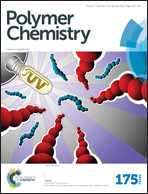Benzo[5]helicene-based conjugated polymers: synthesis, photophysical properties, and application for the detection of nitroaromatic explosives†
Abstract
A series of conjugated polymers based on benzo[5]helicene have been synthesized by employing Sonogashira cross coupling, Suzuki–Miyaura cross coupling and Yamamoto homocoupling reactions. The photophysical properties of these polymers and their fluorescence responses to the nitroaromatic compounds have then been investigated. Quantitative analysis of the fluorescence titration profiles of the polymers with nitroaromatics in solution exhibited that these electron-rich conjugated polymers could selectively detect the nitroaromatic explosives among the electron-deficient aromatic compounds, and the polymers displayed different responses to the nitroaromatics with similar structures. Moreover, the thin film of polymer P2 also sensed the saturated vapors of nitroaromatics sensitively and selectively at room temperature, and the sensing process of the film was reproducible. The fluorescence intensity of P2 revealed a reduction of 87% upon exposure to DNT vapor, and of 70% to TNT vapor in only 10 s. Thus, these new conjugated polymers can be excellent fluorescence sensory materials for detecting nitroaromatic explosives.
![Graphical abstract: Benzo[5]helicene-based conjugated polymers: synthesis, photophysical properties, and application for the detection of nitroaromatic explosives](/en/Image/Get?imageInfo.ImageType=GA&imageInfo.ImageIdentifier.ManuscriptID=C5PY01794G&imageInfo.ImageIdentifier.Year=2016)

 Please wait while we load your content...
Please wait while we load your content...